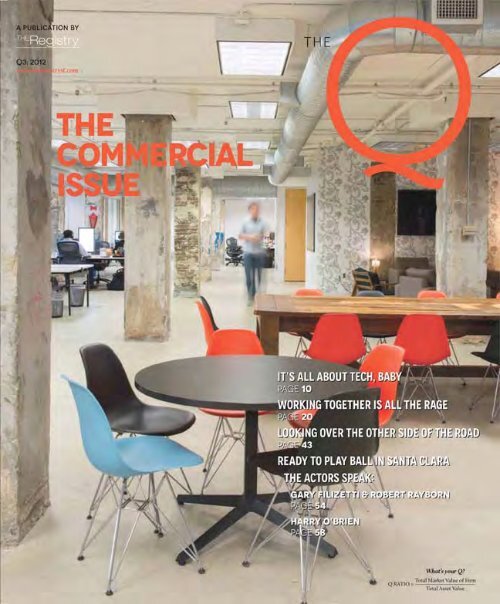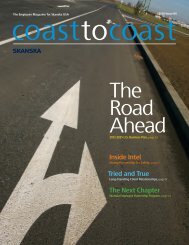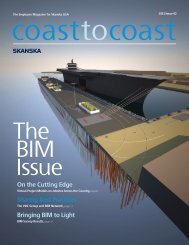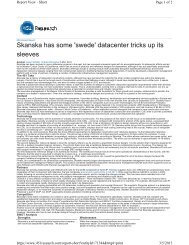You also want an ePaper? Increase the reach of your titles
YUMPU automatically turns print PDFs into web optimized ePapers that Google loves.
profiles/Carnemark<br />
62 Q www.theregistrysf.com<br />
Jakob Carnemark<br />
senior vice president,<br />
<strong>Skanska</strong> USa’s Mission Critical unit<br />
The Data Center Grows Up<br />
Robert Celaschi<br />
BIG DATA MEANS BIG oPPoRTUNITY for<br />
business and other enterprises, but it also<br />
is giving rise to big challenges. For those in<br />
the construction industry, talk has turned<br />
to creating the next generation of data<br />
center to help handle the tsunami of potentially<br />
new intelligence.<br />
Data is growing eight times faster than<br />
IT spending on a yearly basis, according to<br />
construction and engineering firm <strong>Skanska</strong><br />
USA. Wal-Mart alone generates a million<br />
transaction every hour, or about 2.5 petabytes<br />
of data. But if a company wants to<br />
make money from all the info it gathers, data<br />
has to do more than just sit on a hard disk.<br />
“If you have all this data out there, but<br />
The rise of big data plus energy and<br />
infrastructure costs are forcing change<br />
you can’t search it, it is not as valuable,”<br />
said Jakob Carnemark, senior vice president<br />
of <strong>Skanska</strong>’s Mission Critical unit,<br />
which built large data centers for IBM in<br />
Foster City and eBay Inc.’s data center in<br />
Salt Lake City. “What social media companies<br />
are doing is putting their data on servers,<br />
so they can do very fast searches on it.”<br />
But computing demands a lot more<br />
electricity than simple storage. A typical<br />
server draws about 300 watts. Put 50 of<br />
those in a rack, and that’s 1,500 watts. Fill<br />
a building with row after row of racks, and<br />
total power consumption adds up fast.<br />
Today, data centers consume about 1.3<br />
percent of all global electricity, according<br />
to Robert Bryce, a senior fellow with the<br />
Center for Energy Policy and the Environment<br />
at the Manhattan Institute writing in<br />
The Wall Street Journal. That’s more electricity<br />
than is used in some entire countries,<br />
including Australia and Mexico.<br />
When you run a lot of power through<br />
electronic equipment, it generates heat.<br />
Servers, on the other hand, need to stay<br />
cool. This sets up a huge challenge for<br />
managing data centers.<br />
Until now, data center owners and operators<br />
have been able to keep pace, thanks<br />
to Moore’s Law, which holds that the number<br />
of transistors on a computer chip will<br />
double roughly every two years. Between<br />
buying more efficient servers every few<br />
years and adding more real estate, the industry<br />
could get enough capacity to match<br />
the growth in data.<br />
Now the pace at which you can fit more<br />
data in a box is slowing, and the main cost<br />
driver for the data<br />
center is no longer<br />
the IT application;<br />
it is energy and infrastructure.<br />
The<br />
more chips that are packed into a server, the<br />
more energy the server uses, and the more<br />
energy needed to cool, Carnemark said.<br />
How is the explosion of data changing the<br />
job of the chief informa tion officer?<br />
CIos are no longer CIos. They are factory<br />
managers. You have to start looking<br />
at the outcome—what your IT initiatives<br />
create in the way of energy footprint—and<br />
you have to start managing those initiatives.<br />
Companies are starting to see that<br />
the infrastructure and energy costs are far<br />
outstripping other operating expenses.<br />
PUE (power usage effectiveness) is a<br />
good metric, in the sense that it got people<br />
talking about it. But it’s like saying your assembly<br />
line is efficient because of its power<br />
consumption. That doesn’t look at whether<br />
the assembly line is doing anything useful.<br />
What you want to measure is the useful<br />
output and then your expenditure to get<br />
it. PUE is good; it’s your overhead. But you<br />
have to connect it to outcomes.<br />
Social media companies are even recording<br />
mouse movements on the screen,<br />
to understand how people navigate a page.<br />
That creates massive amounts of data.<br />
So what should data centers look at instead<br />
of PUE?<br />
The absolute metric that companies<br />
should focus on is utilization of the asset.<br />
Most companies make a bet based on<br />
growth rate and build data centers much<br />
more massively than they need. Therefore,<br />
they are always under utilizing it.<br />
Say you build a data center for $10 million<br />
per megawatt. Say you spend $100 million.<br />
And then when you move in, the data<br />
center is only partially loaded. Even if you<br />
fill it up after five years, the average over<br />
that five years is only 50 percent, so you are<br />
really spending $20 million a megawatt.<br />
What other choice does a data center<br />
operator have?<br />
You buy it as you buy a utility. Normally, you<br />
build big air-handling systems that are inefficient<br />
under partial loads. We went down<br />
a different road to develop infrastructure<br />
that is independent of what you are filling<br />
up. You can deploy the system in smaller<br />
chunks, like adding a floor to an office, as<br />
needed, for new employees.<br />
We have developed a modular cooling solution,<br />
eoPTI-TRAX, that is six times more<br />
efficient than traditional cooling structures<br />
and up to 30 times more efficient than a traditional<br />
chiller plant at low loads.<br />
How?<br />
There are three components: A hot-aisle<br />
containment assembly; a cooling distribution<br />
unit that takes up less space in a two-
63 Q www.theregistrysf.com<br />
Jakob Carnemark photographed inside ineRTeCH, a research & development facility located in Danbury, Connecticut where the latest and greenest technology to data centers is currently available.<br />
Adam Friedberg
end configuration, where one side can take over if another side<br />
fails; and an external heat-rejection unit that uses 80 percent less<br />
water than a traditional cooling tower. We are able to get the efficiency<br />
of traditional phase change without significant uses of<br />
electrical load.<br />
We are not breaking any laws of thermodynamics. But we get<br />
the efficiency of a refrigerant that has 78 more times the cooling<br />
ability of water, which in turn is more efficient than air. Instead of<br />
being a water-cooled system or air-cooled, it’s neither.<br />
We focused on a developing a technology where we could have<br />
the same overhead for cooling different loads, from 5 kilowatts to<br />
50 kilowatts per rack. And the eoPTI-TRAX system tracks to the<br />
environmental condition and adjusts automatically.<br />
How does “tracking environmental conditions” differ from what data<br />
centers call “air-side cooling,” where you essentially open the windows<br />
and let cool air in?<br />
Most data centers find it difficult to switch to free cooling. They<br />
64 Q www.theregistrysf.com<br />
Social media companies are even recording mouse movements<br />
on the screen, to understand how people navigate a page.<br />
That creates massive amounts of data.<br />
do it only a couple of times a year, once as the winter starts, then<br />
again six months later. They can’t do it daily. This system does.<br />
The problem with using air is that you need good filtering, and<br />
it is costly.<br />
How does this go back to your point of measuring output?<br />
If you look at the pace of IT growth, you are still going to have<br />
more data center growth. The question is building it efficiently so<br />
that companies can afford to continue the pace.<br />
Right now the model is an unsupportable business model. Some<br />
companies are moving their data centers to Finland and Sweden<br />
to take advantage of the cooler weather. We wanted a technology<br />
that would let people build in warmer environments and build<br />
where there is more population density.<br />
For the Bay Area, given that the cost drivers are energy and infrastructure,<br />
the central point of digital infrastructure is that we<br />
come up with ways to support those industries that allow them to<br />
grow and flourish. Q<br />
Prefabricated data center module that <strong>Skanska</strong> is building for national telco client TeLUS<br />
which will soon be one of the most energy-efficient, greenest data centers in the world.<br />
Adam Friedberg









